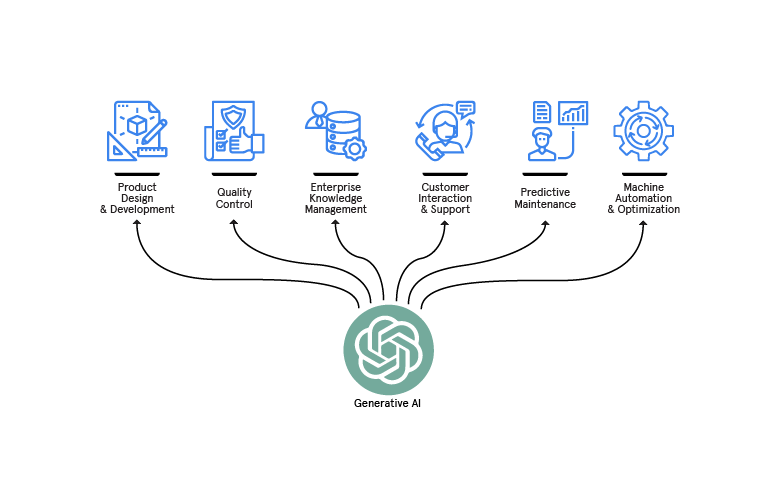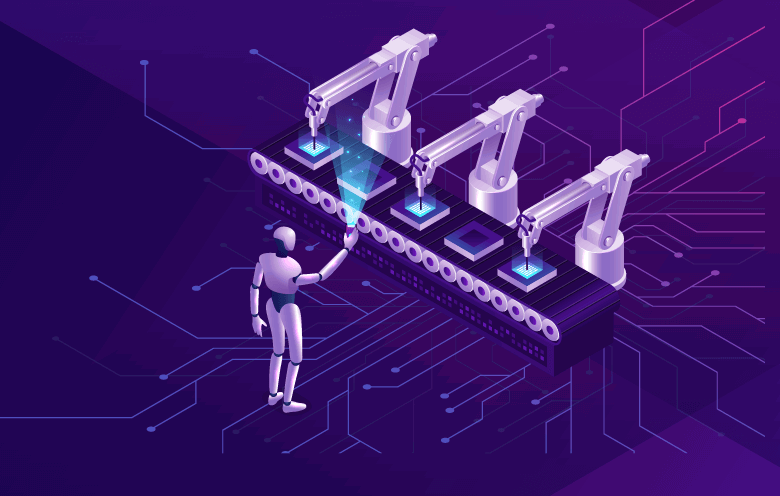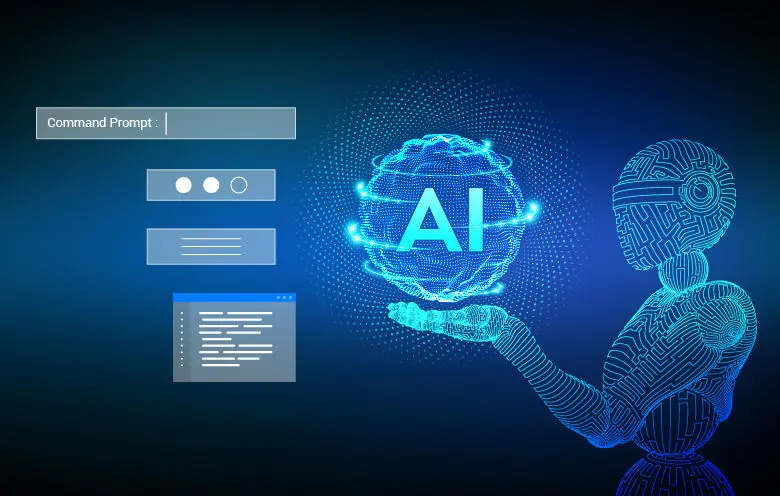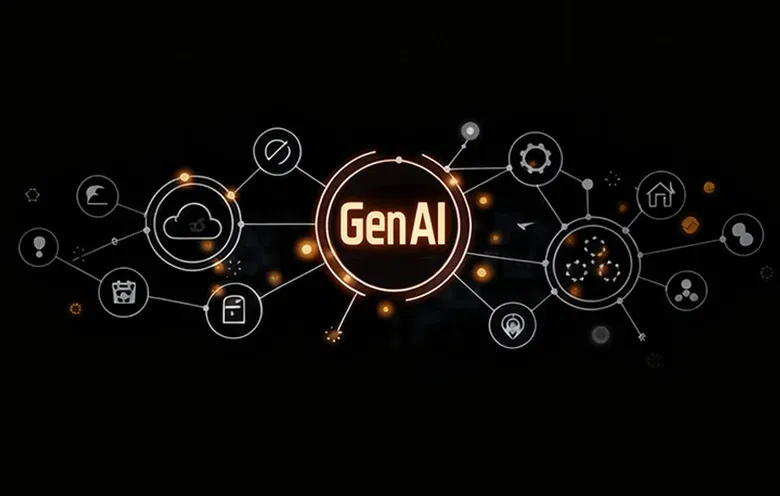The manufacturing industry is on the brink of a major reinvention. Here’s why efficiency is not enough for manufacturers to support growth in the ever-changing economy:
- Shrinking product lifecycles
- Volatile supply chains
- The rising demand for mass customization
There is an increasing necessity to reimagine the way products are designed, workflows are streamlined, and decisions are made on the shop floor. This new age requires tools that transcend automation. Moreover, they also need tools that can simulate, learn, and solve creatively. What was previously a linear, resource-intensive process must now be smarter, quicker, and more responsive to relentless change.
Generative AI (Gen AI) is not just a buzzword; it represents a paradigm shift that empowers manufacturers to harness the full potential of data-driven decision-making and automation. As the manufacturing industry continually embraces digital transformation, generative AI emerges as a key enabler, offering a myriad of applications that revolutionize processes, enhance product quality, and streamline operations.
The evolution of generative AI
Before we delve into the intriguing use cases of generative AI in manufacturing, it’s essential to understand what sets this technology apart. Generative AI is an advanced subset of artificial intelligence, driven by deep learning models such as Generative Adversarial Networks (GANs) and Variational Autoencoders (VAEs). Unlike traditional AI systems that rely on predefined rules and data, generative AI has the remarkable ability to generate new content autonomously.
This autonomous content generation is what makes generative AI a game-changer for manufacturers. It can create designs, simulate outcomes, analyze data, and even engage in human-like conversations. The heart of generative AI is its capacity to learn from vast datasets, enabling it to adapt, refine, and optimize its outputs over time.
Market size
The following whopping numbers say everything about the popularity of AI right now. The generative AI market worldwide is projected to grow by 24.40% resulting in a market volume of $207 billion in 2030.
Source: Statista
Generative AI use cases in manufacturing
Now, let’s embark on a journey to explore some of the use cases of generative AI in the manufacturing industry:

-
Product design and development
In a meticulous fusion of art and science, generative AI utilizes machine learning algorithms to dissect every conceivable design solution for a specific problem, subsequently generating an array of design alternatives. These potential solutions aim to meet objectives defined by engineers, spanning aspects such as operational efficiency, weight, structural integrity, and optimization of material usage. The algorithms learn from each iteration, refining the process until they converge on the most optimal design.
This technology-driven approach unlocks design possibilities far beyond human cognitive capabilities, presenting many design alternatives, including unconventional designs and structures. The result is a transformative shift in product innovation, bringing forth creations that are efficient and cost-effective and inherently unique, effectively positioning businesses at the forefront of their respective industries.
Engineers define specific design goals, constraints, and parameters in the initial phase. These can include objectives related to material costs, manufacturing methods, performance criteria, and operational conditions. The generative AI system then uses this input to generate various design solutions that satisfy these conditions.
- Increased design efficiency: Designing is much faster when compared to human designers, accelerating the design process and significantly reducing the time to market.
- Enhanced innovation: Increased innovation and creativity in product design by exploring a comprehensive design space and creating non-intuitive design solutions.
- Improved performance: Outperforming traditional designs by improving efficiency, reducing weight, enhancing strength, and optimizing material usage.
- Cost savings: Reduced material waste, minimizing the need for physical prototypes, and streamlining the design process lead to significant cost savings.
-
Quality control
Generative AI is pivotal in maintaining product quality and overseeing production in the manufacturing industry. Traditional methods of identifying internal equipment malfunctions often prove challenging, even for experts, given the complexity of diagnosing issues solely based on functional observation. However, integrating AI and machine learning technologies presents a game-changing solution.
Generative AI systems can swiftly pinpoint even the most minute equipment defects. By leveraging these systems, the detection of potential issues becomes proactive rather than reactive, significantly reducing downtime and costs related to sudden equipment failure.
Sensors attached to crucial machinery gather data throughout the manufacturing process. Advanced algorithms then analyze this data, identifying any aberrations and patterns indicative of impending issues. By doing so, generative AI allows for real-time intervention, proactively averting problems and ensuring a smooth and efficient production flow, offering significant operational benefits for the manufacturing industry.
Generative AI systems detect potential errors and alert stakeholders in real time, mitigating large-scale production issues before they escalate. These AI-powered systems actively self-monitor and instantly report production defects.
-
Enterprise knowledge management
The manufacturing sector’s expansion often results from mergers and acquisitions, leading to a siloed infrastructure of systems and processes. This can make locating the appropriate and relevant information a considerable challenge for many employees, leading to considerable time waste and reduced productivity. Implementing an enterprise knowledge bot powered by a sophisticated language model like ChatGPT can be a game-changer in addressing this issue.
Such a bot can drastically reduce employees’ time seeking information, resulting in a notable boost in productivity. Generative AI applications like ChatGPT excel in understanding and generating human-like text, enabling them to sift through vast amounts of data and extract precise and relevant information based on user queries. They can be trained on a wide range of data, from product manuals to internal process guidelines, which makes them a one-stop source for enterprise-wide information.
Additionally, these AI models can adapt and learn from new information, ensuring that the knowledge they provide remains up-to-date and relevant and helping to maintain a continual learning process within the enterprise.
The functionality of such an AI bot can also be extended to discern business rules from legacy applications, even in cases where documentation may be lacking. This capacity to extract and interpret knowledge from diverse sources can help organizations effectively manage and leverage their accumulated knowledge, leading to improved decision-making processes, streamlined operations, and enhanced productivity while fostering an environment of continuous learning and improvement.
-
Customer interactions and support solutions
By leveraging its capacity to emulate human-like conversation, generative AI can improve client experiences and serve as a virtual representative for manufacturers, fielding inquiries and providing product information around the clock.
Generative AI systems are capable of continuous service, reducing the reliance on human customer service agents. This frees up human resources for more complex tasks and enhances operational efficiency and productivity within the organization.
One of the core strengths of generative AI lies in its ability to rapidly analyze, categorize, and draw insights from extensive customer data. This includes product usage, feedback, preferences, purchasing patterns, and more information. By discerning trends, these AI systems can augment customer experiences, customize product offerings and preemptively identify potential concerns before they escalate into larger issues.
Another significant aspect of generative AI is its learning capability – it becomes more accurate and effective by learning from each customer interaction. This continuous learning process results in more personalized and efficient customer service, further boosting customer satisfaction and loyalty. Moreover, the ability of generative AI to handle a large volume of inquiries without additional personnel aids companies in scaling their operations effectively. This can be particularly beneficial in the manufacturing sector during product launches or peak demand periods when customer inquiries tend to surge.
-
Predictive maintenance powered by behavioral analysis
This process begins with extensive data collection through numerous sensors installed on the machinery. These sensors continuously monitor operational parameters such as temperature, vibration, pressure, and acoustics, providing a wealth of data about the machine’s operation and condition. This raw data then undergoes a feature extraction process, where vital patterns and characteristics that offer meaningful insights into the machine’s operation and health are identified. A generative model, such as a Generative Adversarial Network (GAN) or a Variational Autoencoder (VAE), is then trained on these features. The training allows the model to understand the normal operational behavior of the equipment, setting a benchmark for detecting anomalies.
Once trained, the model continuously scrutinizes real-time operational data and conducts behavioral analysis, contrasting the real-time data with the learned ‘normal’ behavior. Any significant deviation indicates a potential equipment malfunction, highlighting the need for maintenance.
The ability to detect possible malfunctions before they result in equipment failure enables the system to schedule predictive maintenance. Rather than adhering to a standard maintenance schedule, this approach schedules maintenance based on predicted equipment failures, leading to improved operational efficiency and optimized use of maintenance resources.
Moreover, as the system accumulates data over time, the generative model constantly learns and refines its predictions. This ongoing learning enhances the accuracy of predictive maintenance capabilities.
Through its behavioral analysis and continual learning, generative AI presents an innovative and efficient approach to predictive maintenance in manufacturing. By enabling the fine-tuning of production plans and the customization of component-wise maintenance schedules, it not only enhances productivity but also increases process transparency and product availability by significantly transforming the overall efficiency and effectiveness of the manufacturing process.
-
Machine automation and optimization
Generative AI has a transformative role in automating and optimizing processes in the manufacturing sector. These devices gather a wide range of operational and performance data, providing crucial insights into several aspects of the manufacturing process, from equipment health to supply chain efficiency. The accumulated data forms the basis for training generative AI models.
A notable application of these models is in calculating Overall Equipment Effectiveness (OEE), which serves as a crucial gauge of manufacturing operation utilization. It’s the product of three distinct factors: availability, performance, and quality. These factors derive from different foundational metrics, including run times, downtime, speed, output, and quality.
Generative AI models significantly enhance the calculation of these metrics by using real-time data collected from various sensors installed on the machinery. These models are trained to analyze the operational data, calculate OEE metrics, and learn the normal patterns in the data to detect anomalies that might affect the OEE, such as unexpected downtimes or quality issues. The scope of generative AI is wider than we’ve all anticipated, and the need for generative AI in every business will continue to grow.
Benefits of generative AI in the manufacturing industry
Explore the key benefits that generative AI brings to the manufacturing sector:
-
Personalized customer experiences
Generative AI’s ability to analyze customer data and emulate human-like conversations allows for highly personalized customer interactions. This fosters customer loyalty and satisfaction by addressing individual needs promptly and effectively, ultimately driving revenue growth.
-
Streamlined knowledge management
Enterprise knowledge bots powered by generative AI streamline information retrieval and knowledge management. Employees can access accurate and up-to-date information effortlessly, reducing time waste and enhancing overall productivity.
-
Continuous learning and improvement
Generative AI continually learns from new data and experiences, ensuring that it remains relevant and effective over time. This adaptive nature makes it a valuable asset for manufacturers seeking to stay ahead in a rapidly changing industry.
-
Competitive advantage
Incorporating generative AI services into manufacturing operations not only streamlines processes but also positions businesses at the forefront of technological innovation. This competitive advantage can lead to increased market share and profitability.
-
Sustainability and resource optimization
Generative AI plays a pivotal role in resource optimization. Through efficient product design and process optimization, it reduces material waste, energy consumption, and environmental impact, aligning manufacturing practices with sustainability goals.
-
Scalability and flexibility
Generative AI systems are highly scalable and adaptable to various manufacturing environments. They can handle increased production demands during peak periods, making it easier for manufacturers to scale their operations effectively.
Leveraging generative ai for manufacturing excellence
In an era where innovation and efficiency reign supreme, generative AI has emerged as the catalyst that’s reshaping the manufacturing industry. From redefining product design and quality control to predictive maintenance and personalized customer interactions, the applications of Generative AI are boundless.
How can Softweb Solutions help you tap into the potential of generative AI?
At Softweb Solutions, our expertise in AI-driven technologies, combined with a deep understanding of manufacturing processes, positions us as your ideal partner on the path to transformation.
Our tailored AI solutions are designed to:
1. Optimize product design: We employ generative AI to revolutionize your product design process, creating cost-effective, efficient, and innovative solutions that set you apart in the market.
2. Enhance quality control: With our AI-driven systems, you can ensure superior product quality, reduce defects, and minimize recalls, saving both time and resources.
3. Enable predictive maintenance: Say goodbye to unexpected downtimes. Softweb’s predictive maintenance solutions, powered by generative AI, keep your operations running smoothly.
It is imperative to stay in the game, and utilizing the right generative AI services is the right way to go about it. You can contact our AI experts to discuss boundless possibilities that generative AI offers.
Looking for generative AI solutions that fit your business needs?




